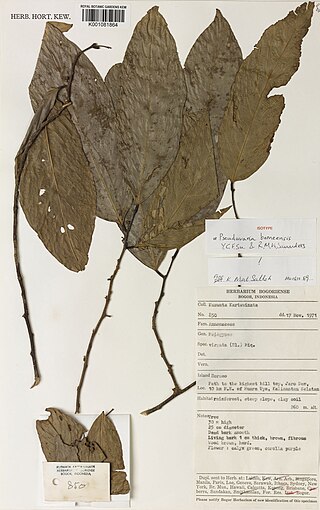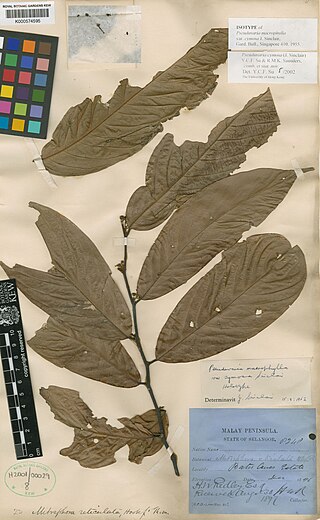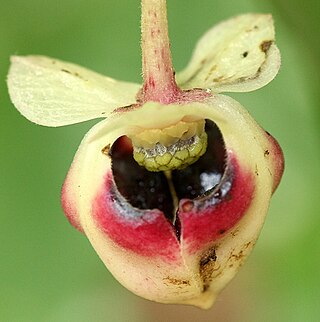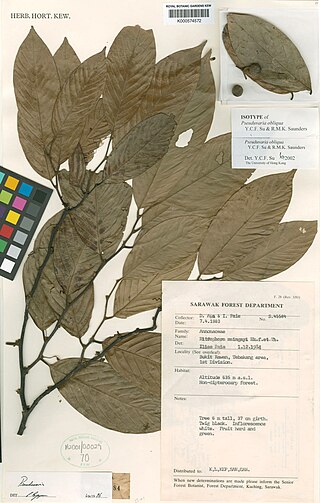Related Research Articles

Pseuduvaria is a genus of the plant family Annonaceae and tribe Miliuseae: with a native range is Tropical Asia.

Uvaria is a genus of flowering plants in the family Annonaceae. The generic name uvaria is derived from the Latin uva meaning grape, likely because the edible fruit of some species in the genus resemble grapes.

Pseuduvaria borneensis is a species of plant in the family Annonaceae. It is endemic to Borneo. Yvonne Chuan Fang Su and Richard M.K. Saunders, the botanists who first formally described the species, named it after the regions of Borneo where it is distributed including East Kalimantan, Sabah and Sarawak.

Pseuduvaria bruneiensis is a species of plant in the family Annonaceae. It is endemic to Borneo. Yvonne Chuan Fang Su and Richard M.K. Saunders, the botanists who first formally described the species, named it after Brunei where the specimens they examined were collected.
Richard M. K. Saunders is a botanist.
Pseuduvaria clemensiae is a species of plant in the family Annonaceae. It is native to New Guinea. Yvonne Chuan Fang Su and Richard M.K. Saunders, the botanists who first formally described the species, named it after Mary Strong Clemens who collected the specimen they examined.
Pseuduvaria coriacea is a species of plant in the family Annonaceae. It is native to New Guinea. Yvonne Chuan Fang Su and Richard M.K. Saunders, the botanists who first formally described the species, named it after its leathery leaves.

Pseuduvaria cymosa is a species of plant in the family Annonaceae. It is native to Peninsular Malaysia. James Sinclair, the Scottish botanist who first formally described the species using the synonym Pseuduvaria macrophylla var. cymosa, named it after its branched inflorescences which are called cymes.

Pseuduvaria glabrescens is a small tree in the custard apple family Annonaceae endemic to a very small part of coastal Queensland, Australia. It was first described as a variety of Pseuduvaria mulgraveana, and later raised to species status.
Pseuduvaria glossopetala is a species of plant in the family Annonaceae. It is native to the Malay Peninsula. Yvonne Chuan Fang Su and Richard M.K. Saunders, the botanists who first formally described the species, named it after the tongue shaped gland on their inner petals.
Pseuduvaria kingiana is a species of plant in the family Annonaceae. It is native to the Malay Peninsula. Yvonne Chuan Fang Su and Richard Saunders, the botanists who first formally described the species, named it after Sir George King, the British botanist who first collected the species.

Pseuduvaria luzonensis is a species of plant in the family Annonaceae. It is native to The Philippines. Elmer Drew Merrill, the American botanist who first formally described the species using the synonym Orophea luzoniensis, named it after Luzon in the province of Battan, Philippines where the specimen he examined was collected along the Lamao River.

Pseuduvaria macrocarpa is a species of plant in the family Annonaceae. It is native to The Maluku Islands and New Guinea. William Burck, the Dutch botanist who first formally described the species using the synonym Meiogyne macrocarpa, named it after its large fruit.

Pseuduvaria megalopus is a species of plant in the family Annonaceae. It is native to New Guinea. Karl Schumann, the German botanist who first formally described the species using the synonym Petalolophus megalopus, named it after the large wings that extend downwards from the underside of the inner petals to form a foot of dark red tissue that resembles carrion and is thought to attract fly pollinators.
Pseuduvaria mindorensis is a species of plant in the family Annonaceae. It is native to the Philippines. Yvonne Su and Richard Saunders, the botanists who first formally described the species, named it after the island of Mindoro where the specimen they examined was collected in the municipality of Puerto Galera.

Pseuduvaria mulgraveana is a species of plant in the family Annonaceae endemic to Queensland, Australia. L.W. Jessup, the botanist who first formally described the species, named it after the Mulgrave River, where the specimen he examined was collected.

Pseuduvaria obliqua is a species of plant in the family Annonaceae. It is native to Borneo. Yvonne Su and Richard Saunders, the botanists who first formally described the species, named it after its slightly uneven leaf bases.
Pseuduvaria oxycarpa is a species of plant in the family Annonaceae. It is native to Sulawesi. Sijfert Hendrik Koorders, the Dutch botanist who first formally described the species, named it after the pointed tips of its fruit.

Pseuduvaria pamattonis is a species of plant in the family Annonaceae. It is native to Borneo and the Philippines. Friedrich Miquel, the Dutch botanist who first formally described the species using the basionym Orophea pamattonis, named it after a mountain in Borneo called Gunung Pamaton.
Pseuduvaria parvipetala is a species of plant in the family Annonaceae. It is native to Borneo and Sumatra. Yvonne Su and Richard Saunders, the botanists who first formally described the species, named it after its small petals.
References
- ↑ Su, C. Y. [許傳芳] (2002). Systematics and phylogeny of Pseuduvaria (Annonaceae) (Doctor of Philosophy). The University of Hong Kong (Pokfulam, Hong Kong). doi:10.5353/th_b4456998.
- ↑ "Su Chuan Fang Yvonne". Duke-NUS Medical School Directory. Duke-NUS Medical School, a school of National University of Singapore. n.d. Retrieved June 22, 2019.
- ↑ International Plant Names Index. Y.C.F.Su.
- ↑ "Pseuduvaria bruneiensis Y.C.F.Su & R.M.K.Saunders". Plants of the World Online. The Trustees of the Royal Botanic Gardens, Kew. n.d. Retrieved June 22, 2019.
- ↑ "Pseuduvaria borneensis Y.C.F.Su & R.M.K.Saunders". Plants of the World Online. The Trustees of the Royal Botanic Gardens, Kew. n.d. Retrieved May 24, 2020.
- ↑ "Pseuduvaria clemensiae Y.C.F.Su & R.M.K.Saunders". Plants of the World Online. The Trustees of the Royal Botanic Gardens, Kew. n.d. Retrieved July 2, 2021.
- ↑ "Pseuduvaria coriacea Y.C.F.Su & R.M.K.Saunders". Plants of the World Online. The Trustees of the Royal Botanic Gardens, Kew. n.d. Retrieved July 2, 2021.
- ↑ "Pseuduvaria cymosa (J.Sinclair) Y.C.F.Su & R.M.K.Saunders". Plants of the World Online. The Trustees of the Royal Botanic Gardens, Kew. n.d. Retrieved July 2, 2021.
- ↑ "Pseuduvaria fragrans Y.C.F.Su, Chaowasku & R.M.K.Saunders". Plants of the World Online. The Trustees of the Royal Botanic Gardens, Kew. n.d. Retrieved July 6, 2021.
- ↑ "Pseuduvaria glabrescens (Jessup) Y.C.F.Su & R.M.K.Saunders". Plants of the World Online. The Trustees of the Royal Botanic Gardens, Kew. n.d. Retrieved July 8, 2021.
- ↑ "Pseuduvaria glossopetala Y.C.F.Su & R.M.K.Saunders". Plants of the World Online. The Trustees of the Royal Botanic Gardens, Kew. n.d. Retrieved July 9, 2021.
- ↑ "Pseuduvaria kingiana Y.C.F.Su & R.M.K.Saunders". Plants of the World Online. The Trustees of the Royal Botanic Gardens, Kew. n.d. Retrieved July 12, 2021.
- ↑ "Pseuduvaria luzonensis (Merr.) Y. C. F. Su & R. M. K. Saunders". Catalogue of Life. Species 2000. n.d. Retrieved July 13, 2021.
- ↑ "Pseuduvaria macrocarpa (Burck) Y.C.F.Su & R.M.K.Saunders". Plants of the World Online. The Trustees of the Royal Botanic Gardens, Kew. n.d. Retrieved July 13, 2021.
- ↑ "Pseuduvaria megalopus (K.Schum.) Y.C.F.Su & Mols". Plants of the World Online. The Trustees of the Royal Botanic Gardens, Kew. n.d. Retrieved July 15, 2021.
- ↑ "Pseuduvaria mindorensis Y.C.F.Su & R.M.K.Saunders". Plants of the World Online. The Trustees of the Royal Botanic Gardens, Kew. n.d. Retrieved July 20, 2021.
- ↑ "Pseuduvaria obliqua Y.C.F.Su & R.M.K.Saunders". Plants of the World Online. The Trustees of the Royal Botanic Gardens, Kew. n.d. Retrieved July 23, 2021.